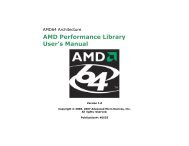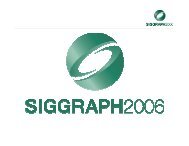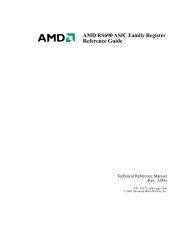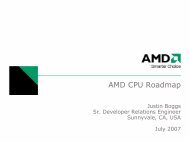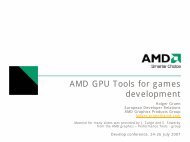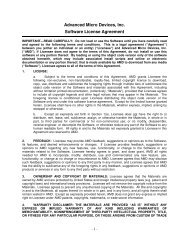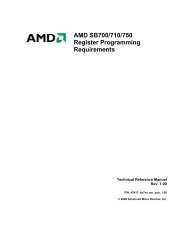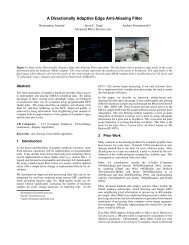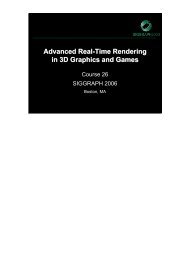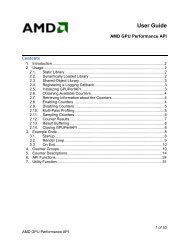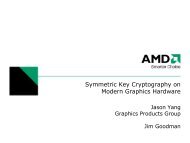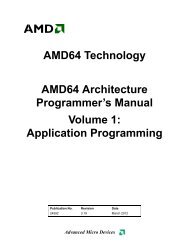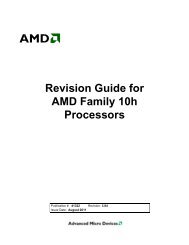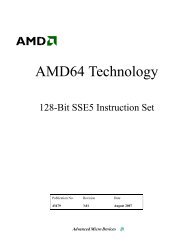Fast Approximations for lighting of Dynamic Scenes
Fast Approximations for lighting of Dynamic Scenes
Fast Approximations for lighting of Dynamic Scenes
Create successful ePaper yourself
Turn your PDF publications into a flip-book with our unique Google optimized e-Paper software.
<strong>Fast</strong> <strong>Approximations</strong> <strong>for</strong> <strong>lighting</strong> <strong>of</strong><br />
<strong>Dynamic</strong> <strong>Scenes</strong><br />
Alex Evans<br />
Media Molecule Ltd
Contents<br />
• Differentiation in games rendering<br />
• Blending techniques to exploit problem<br />
constraints<br />
• ‘Small world’ <strong>lighting</strong> using volumes<br />
– Example 1: Irradiance slices<br />
– Example 2: Signed Distance Functions<br />
– Example 3: View aligned irradiance volumes
Differentiation<br />
• Need to visually differentiate product<br />
– Especially in competitive world <strong>of</strong> games<br />
• Everyone has the same HW to work with<br />
– So need to be creative with constraints…<br />
– ‘I need lots <strong>of</strong> lights’<br />
• So go with a deferred renderer<br />
– ‘I need lots <strong>of</strong> transparent objects’<br />
• So don’t go with a deferred renderer<br />
Ultimately all these algorithms are about servicing a look, art director or game<br />
designer.
Exploiting techniques by blending them<br />
Always worth thinking <strong>of</strong> one technique in terms <strong>of</strong> another. eg first order SH are<br />
kinda AO, and 1st order are like bent normals, oh right, zonal harmonics, oh right so<br />
this relates to eg horizon maps and occlusion discs and <strong>for</strong>m factors.<br />
.... and having made those connections, gpu acceleration papers are popping up all<br />
over the place and so you begin to exploit them.in the same way, intuitions gained<br />
in one algorithm can be re-applied to another one, when they are thought about<br />
using the same ‘language’, and get ‘blended’ ☺
Exploiting techniques by blending them<br />
Always worth thinking <strong>of</strong> one technique in terms <strong>of</strong> another. eg first order SH are<br />
kinda AO, and 1st order are like bent normals, oh right, zonal harmonics, oh right so<br />
this relates to eg horizon maps and occlusion discs and <strong>for</strong>m factors.<br />
.... and having made those connections, gpu acceleration papers are popping up all<br />
over the place and so you begin to exploit them.in the same way, intuitions gained<br />
in one algorithm can be re-applied to another one, when they are thought about<br />
using the same ‘language’, and get ‘blended’ ☺
Exploiting techniques by blending them<br />
Always worth thinking <strong>of</strong> one technique in terms <strong>of</strong> another. eg first order SH are<br />
kinda AO, and 1st order are like bent normals, oh right, zonal harmonics, oh right so<br />
this relates to eg horizon maps and occlusion discs and <strong>for</strong>m factors.<br />
.... and having made those connections, gpu acceleration papers are popping up all<br />
over the place and so you begin to exploit them.in the same way, intuitions gained<br />
in one algorithm can be re-applied to another one, when they are thought about<br />
using the same ‘language’, and get ‘blended’ ☺
Exploiting techniques by blending them<br />
Always worth thinking <strong>of</strong> one technique in terms <strong>of</strong> another. eg first order SH are<br />
kinda AO, and 1st order are like bent normals, oh right, zonal harmonics, oh right so<br />
this relates to eg horizon maps and occlusion discs and <strong>for</strong>m factors.<br />
.... and having made those connections, gpu acceleration papers are popping up all<br />
over the place and so you begin to exploit them.in the same way, intuitions gained<br />
in one algorithm can be re-applied to another one, when they are thought about<br />
using the same ‘language’, and get ‘blended’ ☺
Exploiting techniques by blending them<br />
Always worth thinking <strong>of</strong> one technique in terms <strong>of</strong> another. eg first order SH are<br />
kinda AO, and 1st order are like bent normals, oh right, zonal harmonics, oh right so<br />
this relates to eg horizon maps and occlusion discs and <strong>for</strong>m factors.<br />
.... and having made those connections, gpu acceleration papers are popping up all<br />
over the place and so you begin to exploit them.in the same way, intuitions gained<br />
in one algorithm can be re-applied to another one, when they are thought about<br />
using the same ‘language’, and get ‘blended’ ☺
Exploiting techniques by blending them<br />
Always worth thinking <strong>of</strong> one technique in terms <strong>of</strong> another. eg first order SH are<br />
kinda AO, and 1st order are like bent normals, oh right, zonal harmonics, oh right so<br />
this relates to eg horizon maps and occlusion discs and <strong>for</strong>m factors.<br />
.... and having made those connections, gpu acceleration papers are popping up all<br />
over the place and so you begin to exploit them.in the same way, intuitions gained<br />
in one algorithm can be re-applied to another one, when they are thought about<br />
using the same ‘language’, and get ‘blended’ ☺
Exploiting techniques by blending them<br />
Always worth thinking <strong>of</strong> one technique in terms <strong>of</strong> another. eg first order SH are<br />
kinda AO, and 1st order are like bent normals, oh right, zonal harmonics, oh right so<br />
this relates to eg horizon maps and occlusion discs and <strong>for</strong>m factors.<br />
.... and having made those connections, gpu acceleration papers are popping up all<br />
over the place and so you begin to exploit them.in the same way, intuitions gained<br />
in one algorithm can be re-applied to another one, when they are thought about<br />
using the same ‘language’, and get ‘blended’ ☺
Exploiting techniques by blending them<br />
Always worth thinking <strong>of</strong> one technique in terms <strong>of</strong> another. eg first order SH are<br />
kinda AO, and 1st order are like bent normals, oh right, zonal harmonics, oh right so<br />
this relates to eg horizon maps and occlusion discs and <strong>for</strong>m factors.<br />
.... and having made those connections, gpu acceleration papers are popping up all<br />
over the place and so you begin to exploit them.in the same way, intuitions gained<br />
in one algorithm can be re-applied to another one, when they are thought about<br />
using the same ‘language’, and get ‘blended’ ☺
Exploiting techniques by blending them<br />
Always worth thinking <strong>of</strong> one technique in terms <strong>of</strong> another. eg first order SH are<br />
kinda AO, and 1st order are like bent normals, oh right, zonal harmonics, oh right so<br />
this relates to eg horizon maps and occlusion discs and <strong>for</strong>m factors.<br />
.... and having made those connections, gpu acceleration papers are popping up all<br />
over the place and so you begin to exploit them.in the same way, intuitions gained<br />
in one algorithm can be re-applied to another one, when they are thought about<br />
using the same ‘language’, and get ‘blended’ ☺
Exploiting techniques by blending them<br />
Always worth thinking <strong>of</strong> one technique in terms <strong>of</strong> another. eg first order SH are<br />
kinda AO, and 1st order are like bent normals, oh right, zonal harmonics, oh right so<br />
this relates to eg horizon maps and occlusion discs and <strong>for</strong>m factors.<br />
.... and having made those connections, gpu acceleration papers are popping up all<br />
over the place and so you begin to exploit them.in the same way, intuitions gained<br />
in one algorithm can be re-applied to another one, when they are thought about<br />
using the same ‘language’, and get ‘blended’ ☺
Exploiting techniques by blending them<br />
Always worth thinking <strong>of</strong> one technique in terms <strong>of</strong> another. eg first order SH are<br />
kinda AO, and 1st order are like bent normals, oh right, zonal harmonics, oh right so<br />
this relates to eg horizon maps and occlusion discs and <strong>for</strong>m factors.<br />
.... and having made those connections, gpu acceleration papers are popping up all<br />
over the place and so you begin to exploit them.in the same way, intuitions gained<br />
in one algorithm can be re-applied to another one, when they are thought about<br />
using the same ‘language’, and get ‘blended’ ☺
Exploiting techniques by blending them<br />
Always worth thinking <strong>of</strong> one technique in terms <strong>of</strong> another. eg first order SH are<br />
kinda AO, and 1st order are like bent normals, oh right, zonal harmonics, oh right so<br />
this relates to eg horizon maps and occlusion discs and <strong>for</strong>m factors.<br />
.... and having made those connections, gpu acceleration papers are popping up all<br />
over the place and so you begin to exploit them.in the same way, intuitions gained<br />
in one algorithm can be re-applied to another one, when they are thought about<br />
using the same ‘language’, and get ‘blended’ ☺
Exploiting techniques by blending them<br />
Always worth thinking <strong>of</strong> one technique in terms <strong>of</strong> another. eg first order SH are<br />
kinda AO, and 1st order are like bent normals, oh right, zonal harmonics, oh right so<br />
this relates to eg horizon maps and occlusion discs and <strong>for</strong>m factors.<br />
.... and having made those connections, gpu acceleration papers are popping up all<br />
over the place and so you begin to exploit them.in the same way, intuitions gained<br />
in one algorithm can be re-applied to another one, when they are thought about<br />
using the same ‘language’, and get ‘blended’ ☺
Exploiting techniques by blending them<br />
Always worth thinking <strong>of</strong> one technique in terms <strong>of</strong> another. eg first order SH are<br />
kinda AO, and 1st order are like bent normals, oh right, zonal harmonics, oh right so<br />
this relates to eg horizon maps and occlusion discs and <strong>for</strong>m factors.<br />
.... and having made those connections, gpu acceleration papers are popping up all<br />
over the place and so you begin to exploit them.in the same way, intuitions gained<br />
in one algorithm can be re-applied to another one, when they are thought about<br />
using the same ‘language’, and get ‘blended’ ☺
Exploiting techniques by blending them<br />
Always worth thinking <strong>of</strong> one technique in terms <strong>of</strong> another. eg first order SH are<br />
kinda AO, and 1st order are like bent normals, oh right, zonal harmonics, oh right so<br />
this relates to eg horizon maps and occlusion discs and <strong>for</strong>m factors.<br />
.... and having made those connections, gpu acceleration papers are popping up all<br />
over the place and so you begin to exploit them.in the same way, intuitions gained<br />
in one algorithm can be re-applied to another one, when they are thought about<br />
using the same ‘language’, and get ‘blended’ ☺
Exploiting techniques by blending them<br />
Always worth thinking <strong>of</strong> one technique in terms <strong>of</strong> another. eg first order SH are<br />
kinda AO, and 1st order are like bent normals, oh right, zonal harmonics, oh right so<br />
this relates to eg horizon maps and occlusion discs and <strong>for</strong>m factors.<br />
.... and having made those connections, gpu acceleration papers are popping up all<br />
over the place and so you begin to exploit them.in the same way, intuitions gained<br />
in one algorithm can be re-applied to another one, when they are thought about<br />
using the same ‘language’, and get ‘blended’ ☺
Exploiting techniques by blending them<br />
Always worth thinking <strong>of</strong> one technique in terms <strong>of</strong> another. eg first order SH are<br />
kinda AO, and 1st order are like bent normals, oh right, zonal harmonics, oh right so<br />
this relates to eg horizon maps and occlusion discs and <strong>for</strong>m factors.<br />
.... and having made those connections, gpu acceleration papers are popping up all<br />
over the place and so you begin to exploit them.in the same way, intuitions gained<br />
in one algorithm can be re-applied to another one, when they are thought about<br />
using the same ‘language’, and get ‘blended’ ☺
Exploiting techniques by blending them<br />
Always worth thinking <strong>of</strong> one technique in terms <strong>of</strong> another. eg first order SH are<br />
kinda AO, and 1st order are like bent normals, oh right, zonal harmonics, oh right so<br />
this relates to eg horizon maps and occlusion discs and <strong>for</strong>m factors.<br />
.... and having made those connections, gpu acceleration papers are popping up all<br />
over the place and so you begin to exploit them.in the same way, intuitions gained<br />
in one algorithm can be re-applied to another one, when they are thought about<br />
using the same ‘language’, and get ‘blended’ ☺
Getting the look<br />
• To plagiarise from Chris’s talk on gooey<br />
material rendering:<br />
– [Choose techniques which are] Computationally<br />
efficient:<br />
• Forget about being physically correct<br />
• Focus on approximating the right “look”<br />
• This is a great summary <strong>of</strong> the motivations<br />
behind the following 3 case studies.
Case study: Fake GI in small worlds<br />
• Bounce light effects aid realism greatly<br />
– But come at a cost. The real tricky part is always<br />
the same: efficient computation <strong>of</strong> visibility point<br />
to point or area to area is hard<br />
– Different constraints make it tractable:<br />
• PRT – static scenes<br />
8/8/2006<br />
• Irradiance Caching / Vertex <strong>lighting</strong> – reduce number <strong>of</strong><br />
samples <strong>of</strong> hard-to-evaluate visibility function
Unusual constraint: ‘Small Small world’ world<br />
• If the world was small…<br />
– I could compute/store in<strong>for</strong>mation about the whole world,<br />
dynamically<br />
– I could store that data in GPU friendly data structures<br />
• Volume textures!<br />
– Pros/cons:<br />
• May make traditionally hard queries like visibility, fast<br />
• Simpler to represent scene-wide effects rather than just 'light interacts<br />
with surface‘<br />
• May be low or even constant cost regardless <strong>of</strong> scene<br />
complexity<br />
– This is one <strong>of</strong> the most useful properties <strong>of</strong> PRT <strong>for</strong> games.
8/8/2006<br />
Example 1: Irradiance Slices<br />
• Goal: mixed s<strong>of</strong>t and sharp shadows from dynamic<br />
planar light source with no precomputation
8/8/2006<br />
Example 1: Irradiance Slices<br />
• Inspired by the ‘repeated zoom and blur’ used in<br />
every MP3 player ever
Irradiance slices: the setup<br />
– Imagine a single, large area light<br />
• To shade a point, we want to average many ‘random’ rays<br />
– All ending at the light. They either get there, or they don’t<br />
Key observation: rays near the bottom…<br />
…pass through many <strong>of</strong> the same places rays<br />
near the top did
Irradiance slices: the idea<br />
– So, slice world parallel to light<br />
• Store a texture at each slice
Irradiance slices: the idea<br />
Trace rays from each plane in turn, starting nearest the light<br />
If a ray gets to the previous plane, stop tracing<br />
And just return the result at the previous plane
Demo<br />
• That was pretty abstract so be<strong>for</strong>e I describe how<br />
to do it on GPU, have a demo…<br />
– The artefacts as you move the light around<br />
• Are caused by only updating ¼ <strong>of</strong> the slices per frame.<br />
– Demo written <strong>for</strong> a 9600 mobility– on modern kit, no need any<br />
more!<br />
– Features this has that are nice:<br />
• Sharp and s<strong>of</strong>t shadows can intermix correctly<br />
• Real inner and outer shadow penumbras<br />
• Completely dynamic. Fixed cost. Low geometry Cost
Irradiance slices on the GPU<br />
– How to represent the scene geometry?<br />
• Render a front and back zbuffer <strong>for</strong> each slice<br />
– Using MRT’s, with min-blending, can render 16 per pass<br />
– Take care over slices that are inside geometry
Irradiance slices on the GPU 2<br />
– Now we have <strong>for</strong> each slice,<br />
• A min and max z. so tracing a ray within a slice…<br />
– …is just a matter <strong>of</strong> comparing lots <strong>of</strong> z’s<br />
– This is all an approximation!<br />
– But it’s a good one.
Irradiance slices on the GPU 3<br />
• Each slice is stored as a texture…<br />
• A PS2.0 shader can trace one ray per pixel<br />
– We trace a 4x4 block and average by downsampling<br />
• Sadly we can’t write directly to a volume texture<br />
– So the slices are laid out in 2d on a huge 2048x2048 map<br />
• Then at render time, shading is just a texture<br />
lookup!<br />
• Just find nearest point in slice volume and sample<br />
– Will become more efficient as GPUs get more<br />
orthogonal
That’s That s it <strong>for</strong> Irradiance Slices<br />
• Post-Mortem:<br />
– Fixed cost, huge pixel fill rate<br />
• but great results. Not practical…. Yet<br />
– Main source <strong>of</strong> error is z-slice approximation to<br />
scene geometry<br />
• But it allows completely dynamic geometry<br />
– It’s only one light at a time<br />
• Could implement a system using a grid <strong>of</strong> slices<br />
– Allows arbitrary # <strong>of</strong> lights in fixed time<br />
› Also bounce light! (Every wall can be a light)
Example 2: Skylight <strong>for</strong> dynamic scenes<br />
• The goal:
Example 2: SDF’s SDF are your friend<br />
• It would be really handy to know <strong>for</strong> any point<br />
in space, how far are we from the nearest<br />
object?<br />
– Used <strong>for</strong> medial axis computation, computer vision,<br />
sphere tracing in parallax mapping,….<br />
• The Signed Distance Function stores exactly<br />
this in<strong>for</strong>mation.
Quick SDF definition<br />
• For all points in space we define a S(P) such that<br />
– S(P) = 0 when it is on the surface <strong>of</strong> a body<br />
– S(P) > 0 when it is inside any body<br />
– S(P) < 0 when it is outside all bodies<br />
Can use many distance metrics. It turns out <strong>for</strong> our purposes pretty much any old<br />
distance function will do – in particular a gaussian blurred version <strong>of</strong> the binary<br />
image actually accentuates the affect we want, namely surface curvature.
Using SDF’s SDF to measure surface<br />
curvature<br />
• We want that ‘AO’ look – where regions<br />
inside creases and valleys receive less sky<br />
light.<br />
– Surface curvature is a great start.
SDF’s SDF <strong>for</strong> sky <strong>lighting</strong>: the overview<br />
• We stretch a low resolution (128 cubed)<br />
volume over the entire scene<br />
– This will store the SDF, which will be updated on<br />
the fly in a separate pass on the GPU<br />
– At render time, objects simply sample the global<br />
volume texture and use the SDF values to<br />
compute surface curvature.<br />
• Many more details and HLSL code in the course<br />
notes.
Which looks like… like<br />
Not a bad start. But this is still direction free, there is no sense <strong>of</strong> an up/sky vector.<br />
this is a case where experimentation and messing around can really get you a long<br />
way.
SDF as occlusion map<br />
• If we sample SDF at a distance ‘d’ from<br />
surface, we expect result ‘d’ (or –d)…<br />
– Unless there’s another object in the way.
A step back: what’s what s going on here?<br />
• The SDF is really serving as a easy-to-sample<br />
measure <strong>of</strong> the ‘occludedness’ <strong>of</strong> points in space<br />
– We’re not actually making explicit use <strong>of</strong> it’s distance<br />
properties<br />
– Suggests an analogy with deep shadow maps: we just get a<br />
blurry picture <strong>of</strong> how occluded a particular point is.<br />
– What if we were to trace rays through this<br />
volume?<br />
The intuition is: the SDF here is really acting <strong>for</strong> us like a measure <strong>of</strong> occludedness
Tracing rays in the SDF<br />
• If we sample the SDF at several points along<br />
a ray,<br />
– and sum the results,<br />
– treating them like extinction coefficients in a<br />
participating media / deep shadow map style…<br />
– And pre-blur the SDF in a pyramid <strong>of</strong> map-maps so<br />
that objects have an ‘affect’ on a larger and larger<br />
region depending on the pyramid level..<br />
• We can get a really nice approximation to sky light.<br />
This is the ‘blender’ idea I was talking about in the opening. Despite having arrived<br />
at this point via the (well studied) idea <strong>of</strong> SDF’s, we’re now in territory that has a lot<br />
in common with deep shadow maps, participating media, volume rendering, and<br />
irradiance volumes. Which is all good, because we can take intuitions from there<br />
and apply them here.
Tracing rays in the SDF<br />
• In the absence <strong>of</strong> occluders we expect<br />
n<br />
n<br />
∑SDF(P + diN) =−∑di<br />
i= 0<br />
i= 0<br />
• So in the shader we do:<br />
C = exp(k∑ SDF(P + diN) + di) • When you skew ‘N’ towards the sky<br />
– So that you’re tracing rays slightly upwards,<br />
– Upward facing faces naturally get a brighter, less<br />
occluded shade. And we complete the ‘AO’ look<br />
we wanted.
Picture & Demo
Computing the SDF on the GPU<br />
• If the scene is made up <strong>of</strong> rigid bodies…<br />
– Their local SDF’s are constant and can be precomputed or<br />
analytically computed by a pixel shader.<br />
• The precomputed SDF’s can be compressed according to the<br />
physical properties <strong>of</strong> the object: as height fields, radial (cubemap)<br />
type representations, or even as volume textures.<br />
– Then it’s simply a matter <strong>of</strong> ‘min-blending’ the rotated SDF<br />
<strong>for</strong> each body, into the global SDF volume texture<br />
• More details in the course notes.
Doing it on the GPU: slices again… again<br />
• Due to limitations <strong>of</strong> the API used, we need<br />
to render the volume texture <strong>for</strong> the SDF as<br />
slices on a 2D texture:<br />
A vertex shader computes the 4 vertices <strong>of</strong> the eges <strong>of</strong> the most aligned axis <strong>of</strong> the<br />
OBB <strong>of</strong> the object to be rendered, then a pixel shader evluates the SDF. ‘min<br />
blending’ allows multiple objects to be composited together into the SDF, and then<br />
mip map generation gives us the pyramid <strong>of</strong> blurred volumes used in the sampling<br />
<strong>of</strong> the volume. More details in the course notes.
Colour Bleeding and wrap up<br />
• By computing SDF’s <strong>for</strong> each colour channel, and <strong>of</strong>fsetting<br />
each object’s SDF values by their surface albedo,<br />
– Fake bounce light effects are introduced ‘automatically’<br />
• The bounce light isn’t physically correct, or shadowed – but gives visual<br />
queues which viewers are happy to accept as secondary diffuse<br />
reflections.<br />
• This technique gives pleasing ‘AO’ and sky-type <strong>lighting</strong> at very<br />
low cost even <strong>for</strong> high geometric complexity scenes<br />
– But the approximations used are so coarse that the unphysical<br />
nature <strong>of</strong> the <strong>lighting</strong> makes it tricky to use in complex scenes
Example 3: View aligned Irradiance<br />
Volumes<br />
• Goal: fast evaluation <strong>of</strong> <strong>lighting</strong> from multiple<br />
moving light sources in a dynamic scene<br />
– Constraint: Scene has low depth complexity w.r.t.<br />
the eye/camera – ‘2.5D’<br />
– Constraint 2: Has to run really quickly and have<br />
modest memory usage.
Irradiance Volumes<br />
• Many games use irradiance<br />
volumes to store (and<br />
sample) the light flowing<br />
through any point in a<br />
scene<br />
– Normally they are world<br />
aligned and precomputed at<br />
coarse resolution<br />
– They store the irradiance<br />
flowing in any direction,<br />
<strong>of</strong>ten compressed using a<br />
spherical harmonic<br />
representation
View aligned Irradiance Volumes<br />
• In a dynamic scene, it’s not possible to precompute<br />
the irradiance volume<br />
– So we are going to recompute it on the fly using the GPU, at<br />
low resolution, based on a potentially large number <strong>of</strong> light<br />
emitters<br />
• Since we’re recomputing it every frame,<br />
– It makes sense to compute it in screen space.<br />
– In this example, the target constraint was <strong>for</strong> a ‘2.5D’ thin<br />
world, so a small number (16) <strong>of</strong> slices are used, parallel to<br />
the screen. They are evenly spaced in post projective<br />
space, ie evenly spaced in ‘w’. (1/z)
The setup<br />
• Here’s a view <strong>of</strong> the example scene, as seen<br />
in a game editor:
Rendering <strong>of</strong> the lights into the volume<br />
• We additively composite each visible light into the volume by<br />
intersecting its OBB with the slices <strong>of</strong> the volume.<br />
• Irradiance is a function <strong>of</strong> both position and direction…<br />
– I(p,ω)<br />
• The dependence on direction <strong>of</strong> the irradiance at a given point<br />
is <strong>of</strong>ten represented using spherical harmonics<br />
– We can get away with a simpler approximation: we first render just<br />
the average Irradiance over all directions, at each point in space…<br />
– Directional variation is then approximated from the grad (∇) <strong>of</strong> this<br />
‘average irradiance’ field.
The scene lit by a single point source
Irradiance volume visualisation
Using ∇ to approximate directional<br />
dependence
Results (no sun)
Results (with sun)
Video demo
View aligned Irradiance Volumes wrap up<br />
• The algorithm runs very quickly, is simple to<br />
implement and works well on 2.5D scenes<br />
– Care needs to be taken to avoid aliasing in the sampling <strong>of</strong><br />
a volume with so few ‘slices’<br />
• This could be achieved by some degree <strong>of</strong> filtering, blurring at<br />
light render time, or super-sampling <strong>of</strong> the volume at surface<br />
render time<br />
– Interesting potential extension: shadows<br />
• By integrating the slice based ‘radial zoom and blur’ from example<br />
1, occluders could be rendered into the volume and then<br />
iteratively ‘smeared’ outwards according to the light flow direction.
Conclusion<br />
• 3 novel techniques were presented using volume<br />
representations <strong>of</strong> small scenes to ‘get a nice look’<br />
– 1 – repeated zooming and blurring <strong>of</strong> slices through the<br />
scene can give convincing penumbra effects<br />
– 2 – a GPU updated volume texture was used to rapidly<br />
compute occlusion in<strong>for</strong>mation from a ‘skylight’ to give a<br />
nice AO look with some bounce light effects<br />
– 3 – the gradient <strong>of</strong> a screen aligned ‘irradiance volume’ was<br />
used to rapidly compute <strong>lighting</strong> from a potentially large<br />
number <strong>of</strong> moving light sources.
Questions?<br />
• Questions?<br />
• References & more detail on example 2<br />
– Are in the course notes.<br />
• Thanks<br />
– Natasha Tatarchuk @ ATI<br />
– Media Molecule<br />
lex lex mediamolecule.com<br />
• <strong>for</strong> letting me out during crunch



